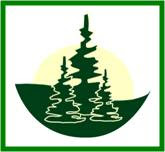 The photo above was taken on an FSC-certified 190 acre woodlot north of Mahone Bay, Lunenburg County, on a crest of a drumlin. This area was previously rough pasture that has reverted back to forest.
The photo above was taken on an FSC-certified 190 acre woodlot north of Mahone Bay, Lunenburg County, on a crest of a drumlin. This area was previously rough pasture that has reverted back to forest.The photo shows a young Yellow birch sapling, about 4 meters tall and of good form, quality and vigor. It's growing underneath a canopy of White spruce and Tamarack larch that are approximately 45 years of age and 17 meters tall. Note that it's growing under a small gap in the upper canopy and is reaching for the light.
This site has good capability for growing high-value trees. The White spruce and particularly the larch could already be harvested for fair-to-high quality log products; but they are still young and can certainly grow longer. In addition, younger classes of both Yellow birch and some White ash that are scattered throughout the site. These are in varying stages, ranging from 3-8 meters tall.
Our recommendation for this area was to begin a light harvest of individual trees, choosing those of the poorest quality including branchy White spruce and some of the forked-topped larch. These trees will not increase in value, and gradually removing them will open gaps in the canopy. This in turn will increase growing space and provide light for the tolerant hardwoods emerging underneath, encouraging their growth.
It will be crucial to keep the harvest light, removing no more than 20-25% of the existing wood volume, because the younger trees need to remain sheltered in order to prevent damage that could be caused by heavy snow and ice. Presently the crowns of the White spruce and larch hold most of the snow and ice that falls on the site, protecting the saplings growing underneath. If too many of these older trees were removed, the young trees would have to take the full weight and would likely break or lean over. These younger trees will need to attain a diameter of at least 15 cm before they will be able to handle this weight.



